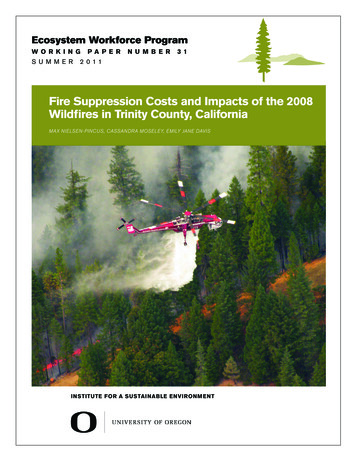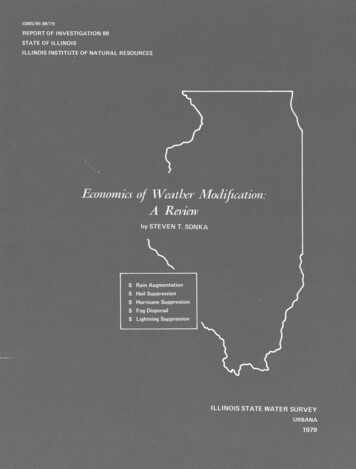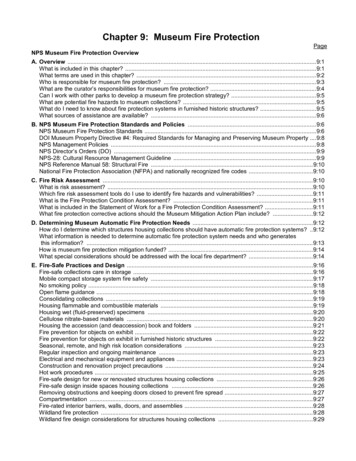
Transcription
Ecosystem Workforce ProgramW O R K I N GS U M M E RPA P E RN U M B E R312 011Fire Suppression Costs and Impacts of the 2008Wildfires in Trinity County, CaliforniaMAX NIELSEN-PINCUS, CASSANDRA MOSELEY, EMILY JANE DAVISINSTITUTE FOR A SUSTAINABLE ENVIRONMENT
About the AuthorsMax Nielsen-Pincus is a faculty research associate in the Ecosystem Workforce Program,Institute for a Sustainable Environment, University of OregonCassandra Moseley is the director of the Ecosystem Workforce Program, Institute for a Sustainable Environment, University of OregonEmily Jane Davis is a faculty research assistant in the Ecosystem Workforce Program, Institute for a Sustainable Environment, University of OregonAcknowledgementsThis research was made possible with support from Joint Fire Sciences Agreement # 09-JV11242309-069. We thank Krista Gebert for obtaining data for this report, Kate MacFarland forediting, and Michelle Medley-Daniel for assistance with the data.All photos by U.S. Forest Service.Map by Liz Podowski.For more information about this reportEcosystem Workforce ProgramInstitute for a Sustainable Environment5247 University of OregonEugene OR 97403-5247T 541-346-4545 F 541-346-2040ewp.uoregon.eduewp@uoregon.eduAn equal-opportunity, affirmative-action institution committed to cultural diversity and compliance with the Americans with Disabilities Act. This publication will bemade available in accessible formats upon request. 2011 University of Oregon DES0911-044ae-B50718
Fire Suppression Costs and Impacts of the 2008 Wildfires in Trinity County, California 1Although wildfire costs are commonly discussed in natural resource policy and research, how wildfire suppression spendingaffects local economies has received relatively littleattention. Wildfires can have multiple and compleximpacts on local economies. Emergency responsecan create work stoppages in natural resource sectors and sectors that rely on natural resources. Poorair quality and risks to human life and property canreduce tourism and recreation in areas affected bywildfire. In contrast, wildfires can support localbusinesses through suppression contracts and procurement of goods and services needed to supportthe suppression effort. How and where suppressionspending is distributed may determine whether thedirect economic impacts of a wildfire are more negative or positive.The purpose of this paper is to investigate how theUSDA Forest Service’s wildfire suppression effort inTrinity County, California, during the summer of2008 impacted the local economy and workforce. Weinvestigated the geographic distribution of suppression spending for the 2008 Trinity County wildfiresand examined employment and wage data for TrinityCounty to begin understanding the economic impacts of large wildfires on local communities. Thecase of Trinity County will help to guide a largersystematic study of the economic impacts of wildfireon a panel of over 360 large wildfires from across theUnited States.ApproachWe gathered data on fire characteristics and suppression costs for the 2008 Trinity County wildfires fromthe National Interagency Fire Management Information Database and Federal Foundation InformationSystem. We examined the cost structure and spatialdistribution of suppression expenditures to begin todevelop an understanding of how the suppression effort might have affected the local economy. We usethis understanding to propose several important research questions about the economic effects of wildfire suppression that can be answered by linking suppression data with employment and wage data fromthe Bureau of Labor Statistics.The 2008 Trinity Countywildlife complexesThe USDA Forest Service and the Bureau of LandManagement manage 89 percent of the land in Trinity County, most of which is classified as severelydeparted from its historic fire regime. On June 20,2008, more than 3,000 lightning strikes sparked over100 wildfires in Trinity and western Siskiyou counties in a matter of hours. Although most of thesefires were quickly extinguished or failed to grow,thirteen large wildfires burned in Trinity Countyfrom late June through October 2008 (Figure 1).Two distinct clusters of wildfire activity occurredon the Shasta-Trinity National Forest. One cluster ofeight wildfires burned along the Trinity River recreation corridor near the communities of Big Bar, DelLoma, and Junction City. A second cluster of wildfires occurred in sparsely populated southeasternTrinity County near the Yolla Bolly Wilderness andthe municipal watershed for several Humboldt Baycommunities. Several other wildfires occurred inFigure 1: Trinity County, California
2Fire Suppression Costs and Impacts of the 2008 Wildfires in Trinity County, Californiathe Trinity Alps and Marble Mountains WildernessAreas, near the community of Hyampom, in westernSiskiyou County on the Klamath National Forest,and in Tehama County just across the border fromthe southeastern Trinity County wildfires. Wildfiresburning in the region shared challenges of isolationfrom transportation networks and difficult terrain.The thirteen Trinity County wildfires burned acrossapproximately 250,000 acres and cost the U.S. ForestService over 150 million in suppression expenses.Trinity County wildfiresuppression spending patternsExpenditure records indicated that nearly half ofall costs for these thirteen wildfires were spent onprivate suppression contracting (Table 1) and that40 percent of those expenditures were to vendors located in or adjacent to Trinity County (only 7 percentwas contracted to firms located in Trinity County).Federal personnel costs accounted for roughly aquarter of the total expenditures, and cooperativeagreements with state suppression agencies accounted for another 15 percent. Local and regional expenditures were highest for private suppression servicesand federal personnel, and relatively negligible forcooperative agreements and flying contracts. The locale of expenditures for supplies and other servicesare more challenging to quantify as the locale for themajority of expenses in this category are classifiedby the location of the credit card company that processed the expenditure rather than the location ofthe vendor. Detailed analysis of transaction recordsindicated that 16 percent of credit card purchasesfor supplies and other services to support the suppression effort were spent in Trinity County and 37percent were spent in adjacent counties.Private-sector vendors from more than 600 counties across the country received payments for goodsor services employed in suppression of the TrinityCounty wildfires. Vendors and government unitsfrom Trinity and Shasta counties were the mostcommon recipients of federal suppression expenses(Table 2). Vendors from Shasta County, California,Deschutes County, Oregon, and Jackson County,Oregon, provided the most private nonaerial suppression services, whereas more specialized flyingcontracts were mostly awarded to vendors fromthree counties in Oregon (Table 3). Federal personnel were employed from 550 counties across thecountry, most commonly from Trinity and adjacentcounties. Cooperative agreements were used to employ resources with state and local agencies locatedin seventy-three counties across the country, mostprominently from California, Colorado, and Alaska.Several local and regional contractors and suppliers were awarded suppression contracts or were theTable 1: 2008 Trinity County wildfire suppression expendituresExpendituresForest ServiceExpenditure ale (%)Private Suppression Services3 73,087,97247407 1Federal Personnel 33,577,7702219712Cooperative Agreements 23,729,52615211Flying Contracts 13,864,7989300Others4 (e.g., supplies, travel) 11,317,8067331028 155,577,8721002353Total1Total( )All expenditures sourced from Trinity, Humboldt, Mendocino, Shasta, Siskiyou, or Tehama counties, California.Only expenditures sourced from Trinity County, California.All contracted services not otherwise classified.All other procurement, predominately materials and supplies.
Fire Suppression Costs and Impacts of the 2008 Wildfires in Trinity County, California 3Table 2: Top ten counties with private vendors or government units receivingpayments for suppression-related activities in the 2008 Trinity County es 13,912,33783%14%0%2%0%Maricopa, AZ1 9,755,0369%3%12%7%69%Trinity, CA 7,820,77166%29%4%0%0%Jackson, OR 7,305,80476%1%0%23%0%Deschutes, OR 6,211,73298%2%0%0%0%Siskiyou, CA 5,996,71984%14%0%1%1%Humboldt, CA 5,461,03682%17%0%0%1%Sacramento, CA 5,050,2903%4%92%0%2%Los Angeles, CA 3,055,8430%25%72%2%1%Tehama, CA 2,967,78695%3%1%1%0%CountyShasta, herExpensesMaricopa, Arizona, is the location of Bank of America, the processor for credit card purchases made by federal personnel and charged to TrinityCounty wildfire accounts. Analysis of specific credit card transactions attributed to Maricopa County, Arizona, indicated that 53 percent were relatedto purchases with vendors located in Trinity County or its adjacent counties (i.e., Humboldt, Mendocino, Shasta, Siskiyou, or Tehama).Table 3: Top five counties with private vendors or government units receivingpayments for suppression-related activities by expenditure categoryCooperative AgreementsFlying Amount*Sacramento, CA 4.6Benton, OR 1.8Trinity, CA 2.3Larimer, CO 2.8Jackson, OR 1.7Shasta, CA 2.0Los Angeles, CA 2.2Josephine, OR 1.1Humboldt, CA 0.9Anchorage, AK 2.0Livingston, MI 1.1Siskiyou, CA 0.9Ventura, CA 1.6Lake, OR 1.1El Dorado, CA 0.8Private Suppression ServicesOther ExpensesCountyCountyAmount*Amount* 11.5Maricopa, AZ1 6.8Deschutes, OR 6.1Arlington, VA 1.5Jackson, OR 5.5Ada, ID 1.2Trinity, CA 5.2Montgomery, MD 0.1Siskiyou, CA 5.1Hennepin, MN 0.1Shasta, CAMaricopa, Arizona, is the location of Bank of America, the processor for credit card purchases made by federal personnel and charged to TrinityCounty wildfire accounts. Analysis of specific credit card transactions attributed to Maricopa County, Arizona, indicated that 53 percent wererelated to purchases with vendors located in Trinity County or its adjacent counties (i.e., Humboldt, Mendocino, Shasta, Siskiyou, or Tehama).* All amounts are expressed in millions.1
4Fire Suppression Costs and Impacts of the 2008 Wildfires in Trinity County, Californiarecipient of substantial credit card purchases to support the suppression effort.Employment and wagesBased on our analysis of federal suppression expenditure data, we would expect direct impacts to Trinity labor markets to be most acute in the public sector, reflecting increases in spending on federal em-ployees. Given the duration, timing, and location ofthe wildfires, we expect impacts to private-sectornatural resource, trade, and hospitality establishments to be more complex, reflecting positive impacts from suppression-related contracting andcredit card purchases at local establishments, butnegative impacts from lost natural resource work,recreation, and tourism.Figure 2: Third-quarter wages for selected sectors ofthe Trinity County economy* 6,000,000Public Sector:Federal 5,000,000Manufacturingwages 4,000,000 3,000,000Trade,Transportation,and Utilities 2,000,000Leisure andHospitality 1,000,000 2002 2003 2004 2005 2006 2007 2008 2009Natural Resourcesand Mining* Shaded column indicates the 2008 wildfire period.Figure 3: Third-quarter employment for selectedsections of the Trinity County economy*600Leisure and HospitalityEmployment500Trade, Transportation,and Utilities400300Public Sector: Federal200Manufacturing10002002 2003 2004 2005 2006 2007 2008 2009* Shaded column indicates the 2008 wildfire period.Natural Resourcesand Mining
Fire Suppression Costs and Impacts of the 2008 Wildfires in Trinity County, California 5Preliminary analysis of Bureau of Labor Statisticsemployment and wage data (Figures 2 and 3) indicates that although federal employment was virtually unchanged in the third quarter of 2008 (comparedto the third quarter of 2007), federal wages increased17 percent over the third quarter of 2007. Private-sector employment in natural resources dropped 23 percent over the third quarter 2007 and wages dropped20 percent. Employment in trade sectors dropped 6percent and wages in those sectors increased by 2percent. Finally, employment in the leisure and hospitality sectors dropped 2 percent, although wagesdropped 14 percent. These preliminary results support our expectations about potential complexitiesof the economic impacts of the 2008 Trinity Countywildfires.ConclusionThe case of the 2008 Trinity County, California, wildfires provides evidence that although the economicvalue created by wildfire suppression contracting iswidely distributed across the country, it is likely tobe most concentrated in and around the physical location of the suppression effort. Nonetheless, TrinityCounty and its adjacent counties received less than aquarter of the 155 million spent by the federal government on the suppression effort in Trinity County,and Trinity County received only about 5 percent ofthat economic input. The biggest inputs to TrinityCounty were for private suppression contracts andfederal wages paid to suppression and coordinatingstaff members. It is also likely that procurement ofgoods and services paid by credit card provided athird major impact to the local economy. Bureau ofLabor Statistics employment and wage data for Trinity County demonstrate a pattern that reflects thesuppression expenditure patterns; a large increase infederal wages, a slight increase in the trade sectors, aslight to moderate drop in the leisure and hospitalitysectors, and a substantial drop in natural resourcesectors. Further investigation, however, is needed toidentify whether those changes might be expectedgiven larger regional, state, and national economictrends.
100 wildfires in Trinity and western Siskiyou coun-ties in a matter of hours. Although most of these fires were quickly extinguished or failed to grow, thirteen large wildfires burned in Trinity County from late June through October 2008 (Figure 1). Two distinct clusters of wildfire activity occurred on the Shasta-Trinity National Forest.











